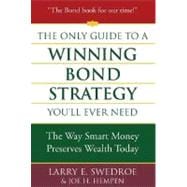
Note: Supplemental materials are not guaranteed with Rental or Used book purchases.
Purchase Benefits
What is included with this book?
| Introduction | 1 | (6) | |
| One: Bondspeak | 7 | (15) | |
| Two: The Risks of Fixed-Income Investing | 22 | (18) | |
| Three: The Buying and Selling of Individual Bonds | 40 | (17) | |
| Four: How the Fixed-Income Markets Really Work | 57 | (28) | |
| Five: The Securities of the U.S. Treasury, Government Agencies, and Government-Sponsored Enterprises | 85 | (18) | |
| Six: The World of Short-Term Fixed-Income Securities | 103 | (18) | |
| Seven: The World of Corporate Fixed-Income Securities | 121 | (21) | |
| Eight: The World of International Fixed-Income Securities | 142 | (12) | |
| Nine: The World of Mortgage-Backed Securities | 154 | (11) | |
| Ten: The World of Municipal Bonds | 165 | (22) | |
| Eleven: How to Design and Construct Your Fixed-Income Portfolio | 187 | (25) | |
| Twelve: Summary | 212 | (4) | |
| Afterword | 216 | (3) | |
| Appendices | 219 | (12) | |
| Notes | 231 | (4) | |
| Glossary | 235 | (18) | |
| Acknowledgments | 253 | (2) | |
| Index | 255 |
The New copy of this book will include any supplemental materials advertised. Please check the title of the book to determine if it should include any access cards, study guides, lab manuals, CDs, etc.
The Used, Rental and eBook copies of this book are not guaranteed to include any supplemental materials. Typically, only the book itself is included. This is true even if the title states it includes any access cards, study guides, lab manuals, CDs, etc.
Excerpted from The Only Guide to a Winning Bond Strategy You'll Ever Need: The Way Smart Money Preserves Wealth Today by Larry E. Swedroe, Joseph H. Hempen
All rights reserved by the original copyright owners. Excerpts are provided for display purposes only and may not be reproduced, reprinted or distributed without the written permission of the publisher.